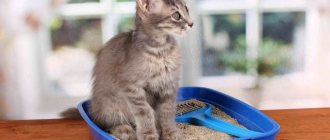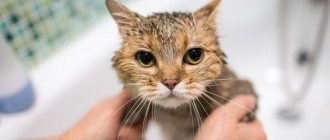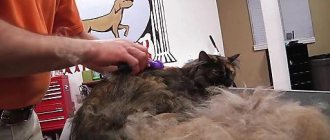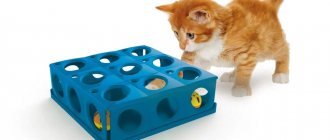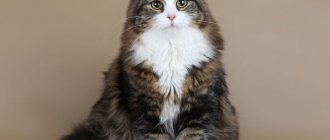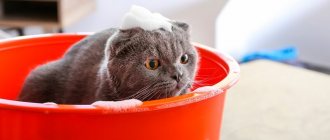Even before the kitten appears in the house, the issue of its toilet should be resolved. In the private sector, a free-ranging cat independently finds secluded places in the yard, but an apartment pet will need a tray and a special filler. There is a huge range of fillers on the market, which can easily mislead the future owner of the animal.
Even 5-10 years ago, many people poured ordinary sand into the tray. However, in this case, an unpleasant aroma hovered throughout the apartment, and grains of sand could be found even on the bed. Today, the problem of unpleasant odor has been solved, and the litter for the toilet will be convenient for the owner, safe for the animal, and the smell of the home will not be spoiled.
How to fill with filler
To understand why litter is needed, you need to know the physiology of cats. In the wild, cats relieve their natural needs in the ground, first digging a hole. Household representatives have no distinctive features and carry out their personal affairs in the same way. The tray filler serves as an analogue of soil, but only adapted to living conditions.
Automatic cat feeder with dispenser and timer, for wet and dry food
Inexperienced owners often make mistakes when trying to choose the optimal amount of litter for the tray. Many people prefer not to bother: they use newspapers, leave the tray empty, or retrain the cat to go to the toilet.
So how much filler should you use? It is difficult to unambiguously determine the volume of filler. But there are approximate values. The height of the wood layer should not exceed 2 cm, sand - 1 cm, mixed and silica gel - no more than 2-3 cm.
Warning! The filler should not completely clog the mesh from the tray.
Tray for cats
All about absorbent cat litter
- 1) Why do you need filler?
- 2) Types of fillers
- 3) Absorbent fillers
- 4) Rules for using absorbent filler
Why litter is needed
Litters were invented to satisfy the need of cats to relieve themselves in a soft and absorbent mixture, and then bury their waste so that there is no characteristic odor left. In this matter, both owners and pets want one thing - to get rid of the source of pungent odors. But everyone decides this to the best of their abilities and capabilities.
Nature itself has built into the behavior of cats the desire to hide the results of their life activity. If the tray is dirty and smells bad, the cat will leave and find a cleaner place. The owner can purchase a high-quality filler that will help effectively combat odors. Filler granules absorb moisture and hide odors in the pores.
How quickly the package runs out, how well it absorbs and eliminates odors, whether it sticks to paws and fur - depends on the brand of the mixture. Pet stores are constantly updating their range of hygiene products for cats. The staff of the Murkosha shelter advise you to take the choice of litter seriously and choose the best option for your pet. After all, this will also determine whether your cat will have problems visiting the litter box.
Read more about the possible reasons for a cat refusing to use the litter box: The cat does not go to the litter box: what to do
Types of fillers
Until recently, you had to choose a filler from two options - sand and scraps of paper. Nowadays a huge number of products are sold. But in this variety it is difficult to navigate and choose. Only together with your pet, through trial and error, can you find a litter that the cat will like and will be comfortable for the owner.
There are two types of compositions that differ in the principle of action. Fillers either absorb moisture and odors (absorbent), or form dense lumps with urine (clumping), which are easy to separate from the main mass.
Absorbent fillers
In the category of absorbent cat litters, the most popular are wood mixtures. They are compressed coniferous sawdust in the form of light bulk granules. When they come into contact with moisture, they quickly absorb it, increase in size and form rot.
To maintain cleanliness in the toilet, you need to replace all the mixture in the tray on average once every 2-3 days. One of the worst things about using absorbent cat litter is the wet sawdust on the paws that gets carried around the house. The pet leaves dirty marks on carpets, furniture and even beds. To prevent this from happening (or at least the paws would not be so dirty), volunteers at the Murkosha shelter advise using disposable rugs or diapers that can be laid out near the tray.
For animals that are used to going to the litter box on a bare grid, wood filler can be poured under it.
Wood absorbent filler has a number of advantages:
- — washes off into the sewer without any problems;
- - lowest cost;
- — the smell of natural wood (therefore it should not scare the cat away from the tray, which in some cases can happen with scented litter);
- — no dust and allergic reactions during use.
This type of absorbent filler is suitable for kittens, because they love to taste everything new and unknown. Even if the baby chews and swallows the granule, it will not cause serious harm.
The category of absorbent litters for cats also includes corn, clay and silica gel.
Corn filler is shredded corn cobs. The environmentally friendly material has a number of other advantages:
- — absorbs liquid efficiently;
- - does not generate dust;
- - does not cause allergies;
- - has an unpleasant taste, which makes this absorbent filler safe for kittens (kids do not have the desire to chew it).
Along with this, there are also disadvantages:
- - requires frequent changes in the tray;
- - gets dirty quickly;
- - the smell appears in a short period of time;
- — the particles are light, which facilitates rapid spread throughout the apartment.
Clay aggregate consists of various types of clay rocks. The quality and characteristics of the mixture depend on the minerals that make up the clay. This absorbent cat litter is similar in properties to sand. Therefore, this particular species, as a rule, is most liked by cats, especially those of them who previously lived on the street and relieved their natural needs simply on the ground. Clay litter can help such cats get used to the litter box faster.
But it also has disadvantages. It is dusty and absorbs a relatively small amount of moisture (however, this depends primarily on the quality of the clay and the brand of filler). The success in combating odors is also small when compared with other types of fillers.
The silica gel type consists of synthetic beads with incredible moisture absorption properties. The absorption of liquid occurs instantly and is accompanied by a hissing sound similar to the sound of slaking lime. The advantages of this absorbent cat litter include:
- - does not require frequent replacement of the mixture - once every 1-1.5 weeks for one pet;
- - reliably hides the smell of urine;
- — successfully copes with its task, even if the tray is used by several cats.
The composition with silica gel differs from the others, being more modern and effective. But it also has its disadvantages, namely:
- — this type of absorbent filler is not suitable for kittens, as they can swallow the balls and die;
- — the highest price among all types of fillers;
- — the hissing that occurs when the granules get wet can scare the cat away from the tray;
- - granules stick to fur and paws and spread throughout the apartment, crumbling under the feet of household members;
- - It is forbidden to flush it down drains due to the risk of blockages.
In some European countries, there is a ban on the use of synthetic and artificial products for pets; only biodegradable and natural ones are allowed. The staff of the Murkosha shelter recommend taking this fact into account.
Read more about the different types of litter: What types of cat litter are there?
Rules for using absorbent filler
The filler is easy to use. You need to fill the tray with a mixture with a layer height of 3 to 10 cm (depending on the type of filler). Many packages give recommendations on the amount of mixture that needs to be poured. Then the product will effectively absorb moisture. The absorbent filler is changed completely as it gets dirty (once every 2-10 days, again, depending on the type and degree of contamination).
Before adding a new portion of filler, the tray must be thoroughly washed and dried. Especially if you use mixtures that do not require too frequent replacement and change the filler every 7-10 days. In this case, you should carry out “general cleaning”: wash all corners of the tray, preferably with a detergent (but only one that does not leave a smell); a solution of soda in warm water will also work. If you use wood litter, then it must be completely changed every 2-3 days (and if more than one cat uses the litter box, then every day). In this case, it is not necessary to wash with detergent every time - it is enough to rinse with warm water, and carry out “general cleaning” once every 2 weeks.
Overall, absorbent litters are a good option. In this category you will find a wide variety of types - from traditional wood to the most modern silica gel. When choosing, be guided by the character and habits of the pet (whether he is accustomed to the natural environment, how much he likes to “dig” into the litter), his age (for kittens it is better to use wood or corn litter), and of course, his individual preferences. If your cat is already accustomed to a specific type of litter (even a specific brand) and uses it without problems, then the Murkoshi team does not recommend changing it without a serious reason - cats do not like sudden changes.
Why do you need a grille?
This accessory has a practical meaning. The filler is poured strictly under the grate, as it absorbs urine. The excrement will remain on top: the owner only needs to remove the part to rinse it under running water.
Some owners try to avoid mesh, citing the cat's physiology as an excuse. In their opinion, the accessory interferes with burying animal waste products, which means it will certainly cause discomfort. In the future, such a solution creates a whole wave of problems: the pet scatters the litter, dirt quickly accumulates and cleaning turns into a daily chore.
Different types of cat litter
Basic rules for using filler
- Spread the product in an even layer at least five centimeters high;
- It is advisable to clean the absorbent woody species every day;
- The absorbent mineral type does not require daily changes. A complete replacement is carried out once every two to five days;
- Absorbent silica gel products need to be completely replaced once every two to four weeks, while regularly removing solid waste and filling up the missing part of the granules. In addition, you need to stir the granules daily so that the moisture is distributed evenly;
- When using the clumping type, after using the tray, immediately remove the formed lumps. Then the missing part of the granules is poured into the container. A complete replacement is carried out every seven to ten days;
- If you use the silica gel version, after use the solid waste is removed and the remaining contents are mixed. A complete replacement is carried out every two to three weeks.
- After completely replacing the product, rinse the tray thoroughly;
- To wash the tray, use water and, if necessary, liquid soap. Do not use special products; due to their chemical composition, they can cause allergies in your pet. In addition, due to the strong smell, cats may refuse to go to the litter box;
- If you are using a tray with a grid, it is best to remove the grid as these containers are designed to be used without any filling. If necessary, the substance can be poured under the grate.
How to wash, how to clean
Hygienic procedures are mandatory when using filler and without it. In the second case, you will have to clean the litter box after each time your pet goes to the toilet.
If the attribute is not taken care of, then one of the consequences is an unpleasant odor that will quickly spread throughout the entire apartment.
But the tailed pet will begin to regularly look for new places to relieve its natural needs, since the smell of excrement scares them away.
To clean your cat's litter box, you will need disinfectant (eco-friendly) detergents, a soft brush and paper towels.
Procedure. Everything will take no more than five minutes.
- The used filler is sent in a plastic bag.
- Having unfastened the removable mesh, the base is washed under warm water.
- Apply or spray detergent onto the tray and leave for a few minutes. Then the base is cleaned with a brush.
- The removable grate is cleaned in warm water.
Tray cleaner
Choosing a detergent
The most important criterion is the absence of strong odors. Be careful when using toilet bowl cleaners. Many of them have a pungent “aroma” that can scare away a cat.
As a result, the pet will have no choice but to go looking for a more comfortable place to go to the toilet.
Acid-containing products effectively fight urinary stones, which settle on the surface of the tray over time. An analogue of these is ordinary vinegar, but it only eliminates the smell and is not suitable for regular cleaning.
Eco-friendly disinfectants are the best option. They smell nothing and contain virtually no chemicals.
How it works
There are two types of filler, differing in their principle of action. The components either absorb secretions and odors, or form dense structures in the form of lumps with urine, which are easily separated from the main mass.
Absorbent filler
Convenient for cats as it quickly absorbs large amounts of liquid. Manufacturers use natural raw materials that are safe for animal health: special types of clay, corn, sawdust, and pulp.
Most manufacturers do not add flavorings, but the composition may include soda, activated carbon or silver ions - these components significantly improve the characteristics of the absorbent filler.
It is inexpensive, but requires more frequent replacement compared to clumping ones, and regular disinfection of the tray itself. There is an advantage to this - with frequent washing, the risk of pathogenic microorganisms multiplying in the contents of the cat litter is much lower.
Important! Opt for an absorbent one if your pet has access to the outdoors (you walk it on a harness or take it to the dacha). Absorbent litter is the best option when there are several cats living in the house.
clumping
This type of brand is more popular, since the clumping filler is convenient for owners. For its production, bentonite is often used, a clay mineral with excellent absorption properties. Wood, paper and some other materials are also used as raw materials.
Why do cat owners love clumping litter? In addition to the obvious advantages - cost-effectiveness and ease of cleaning, some brands have special additives that change color depending on the composition of the urine. So, if the animal is sick, and there are no external symptoms yet, the unusual color of these additives will allow the owner to seek help from a veterinarian in time.
A number of manufacturers include substances that change color when exposed to urine. The purpose of such additives is to clearly define the boundaries of the lump. Therefore, the pet owner can save money by not throwing away clean litter. Many brands contain a variety of fragrances - components that are useless for cats, but pleasant for owners.
How often should I change
Even with regular hygiene procedures, the cat litter box does not have an unlimited shelf life. Like other accessories for animals, it also tends to wear out. The pet himself unconsciously makes “efforts”: he scratches his toilet with his claws, and a white coating may appear at the bottom of the base. Sooner or later, the owner must worry about purchasing a new attribute for his ward.
If cleaning is done on a regular basis, the toilet area can last for several years. However, ignoring the basic rules of care, the stench and particles of waste “eat” into the surface of the tray so that no cleaning products can help. And you can make purchases almost every year.
The tray is placed in a place convenient for the cat
WHAT FILLER SHOULD I CHOOSE FOR A TRAY WITH MESH?
The best one is silica gel. At first glance, it is more expensive than other types of fillers (read about them in the article “Which tray filler is best”). But in fact, silica gel “works” longer and is consumed many times slower than wood or clay granules.
One package of silica gel filler, when used in a tray with a grid, will last you a long time. For a very long time!
Silica gel has its drawbacks: its granules can prick unpleasantly, crunch, get stuck in the paw pads, and stain the fur. Swallowing them is like swallowing concrete. But in a tray with a grid, all these disadvantages do not matter, because the cat does not touch the filler at all.
Where to put it in the apartment
This issue should be resolved on the first day the cat is in the house. The pet must be accustomed to one place for excrement, so that later the owner does not find “surprises” throughout the apartment.
Ideal areas are those that have low traffic and those that have virtually no noise. These are the most comfortable conditions under which the pet will agree to relieve itself and feel safe. Otherwise, “there will be trouble.”
If the choice falls on the toilet, make sure that the ward always has access to it. Residents will have to put up with an open door, or constantly come running when their pet calls.
Advice! Do not change the location of the tray. Cats are very conservative creatures and cannot tolerate any changes in their lives without stress. More temperamental individuals will declare “war” and continue to go where they went before.
How can you tell if your cat's litter box is too small?
He does not sit completely in the tray, but only with his hind legs. Often this indicates that the animal’s tray is very small, although the pet tries to somehow fit into it and not “miss the mark.” Or the small tray is poorly placed to save space. Places one paw in the tray or not at all.
Interesting materials:
Why can't I clear my safari history? Why can't I send jewelry? Why can't you crossbreed fold-eared cats? Why can't you remove the terminal from the battery while the engine is running? Why can't you collect mercury with a vacuum cleaner? Why can't you bring the British and Scots together? Why can't you heat your stove with raw wood? Why can't you hang pictures with a waterfall? Why can't you drive barefoot? Why can't you pull out gray hair?
Can several individuals use one toilet?
Our smaller whiskered brothers are naturally territorial animals. As in the wild, in the house they distribute among themselves places that they will consider their personal possessions. Therefore, the toilet will have to be divided: acquire several attributes and even choose a filler that every cat will like.
But the owner cannot always afford such innovations. Living in a small apartment, a person does not have the opportunity to provide each furry guest with an individual restroom. You will have to train all your pets to relieve themselves in one place.
When training several cats to defecate in the same litter box, be prepared to clean the litter box several times more often. Otherwise, pets will choose their own personal bathroom.
Which to choose?
Now in the pet store you can find a huge number of options for your pets. There are models of different shapes, colors, designs, and you will definitely find the one that will suit you and your pet. Of course, each model has certain advantages and disadvantages, it is important to choose the one that is right for you. In total, there are several types of cat litter:
- Traditional. The simplest option is with low sides, where the cat can not only relieve himself, but also bury (if he has such a habit).
- With bars. One of the most common. The grid, which is a key element of the design, prevents the cat from getting its paws dirty and not coming into contact with the litter.
- With high sides. They help protect the surrounding area of the toilet from contamination by litter or the contents of the tray.
- Closed "house". It will allow your pet to feel as comfortable and protected as possible while relieving itself of natural needs. Retains unpleasant odors well.
How many accessories do you need for one cat?
One tray is enough for an adult. Let us remember that cats are conservative by nature and, as a rule, defecate in only one place. But under certain circumstances, the number of bathrooms can be increased.
- When accustoming a kitten to relieve its natural needs, the owner must determine which location will be preferable for his ward. To do this, you need to put several trays in the apartment where a new member of the household has already visited with certain intentions.
- When a cat changes its place of residence, its litter box also changes. To help the client choose, the owner can also place several trays in different areas of the apartment. And only when the cat decides, leave one attribute.
Automatic waterer for cats, LED battery-powered bowl substitute
HOW TO TRAIN A CAT OR A CAT TO A TRAY WITH A GRATE?
Natural instinct makes cats first dig a hole for the toilet, and then bury it. It is clear that there is nothing to dig in a tray with a grate. How to be?
At first - just for training - pour the filler on top of the grate. To keep your cat safe, use natural litter - wood, paper or corn. When the cat gets used to going to the litter box, you can switch to silica gel. And so that the cat doesn’t get confused at the sight of the “new” tray:
- put some already used filler into a bag;
- When adding silica gel for the first time, add old used filler to it.
The cat will come to the familiar smell and understand what to do.
toilet
Comments ()
Log in to leave a comment
How to change the filler correctly?
The frequency of changing the filler depends on its type. For example, wood pellets that have been exposed to urine will scatter at the bottom of the tray. They are separated with a spatula from the surviving granules and thrown away. If there are no whole ones left, then remove all sawdust from the tray and wash it well under running water.
This type of litter can be changed once a week, provided that only one pet uses the toilet.
You can use cat litter, such as silica gel, for two weeks and only then change it completely. But it is better to remove already used lumps immediately. And the contents of the tray need to be stirred periodically for quick drying.
The mixed filler is also changed once a week. To do this, you need to use a special spatula with holes through which the used filler will be sifted from the clean one. After this procedure, fresh granules are added to the container.
Sand is the weakest among its competitors; it should be changed completely, preferably every day.
In addition, wet cleaning will be required around the tray, as grains of sand may spill outside of it. Each owner can decide for himself how much filler to add by observing the animal.
Required amount of filler per cat:
- wood filler - 1 layer;
- silica gel - 2 cm in height;
- mixed - 3 cm;
- sand - 1 cm.
All types of fillers have different granule sizes. This is convenient because you can buy small stones for kittens, in which they will rummage with interest, and this will help them quickly get used to the toilet.
Pros and cons of silica gel
A new type of filler is silicon dioxide granules, which can be transparent or tinted. Made from dried gel, the granules can be round beads or crystals. Depending on the size of the cat and its litter box, you can choose litter with large, medium or small crystals.
Advantages of silica gel cat litter:
- Silica gel has a large pore area, which allows it to easily adsorb liquid and reduce humidity in a confined space by forty percent.
- The material is chemically inactive and does not burn, therefore it is completely safe.
- It has high mechanical strength and chemical resistance.
- Crystals or balls absorb a lot of liquid, which allows you to change the contents of the tray much less often. As a result, one 3.8 liter bag lasts one pet for about two weeks.
- In the room where a toilet with silicone granules is installed, all unpleasant odors and excess moisture are eliminated.
- The granules do not stick to the cat's paws and do not emit dust. If you place a tray with large sides, then even after the animal buries its feces, the floor in the room will remain clean.
- The crystalline filler does not harbor bacteria or mold.
But, despite the large number of advantages, silica gel has several disadvantages:
- The granules should not be flushed down the toilet. They can only be disposed of with household waste.
- Cats who tend to eat everything can experience serious stomach problems if they ingest crystals. It is not recommended to use a silica gel toilet for such animals.
- Daily stirring of the granules is required, otherwise after they are completely saturated, a puddle will form in the cat's litter box.
- Hard crystals have sharp edges that can injure the delicate paws of a kitten or cat.
- When absorbing moisture, silica gel crackles and hisses, which can frighten your pet. It also makes noise when the cat starts digging into the litter.



